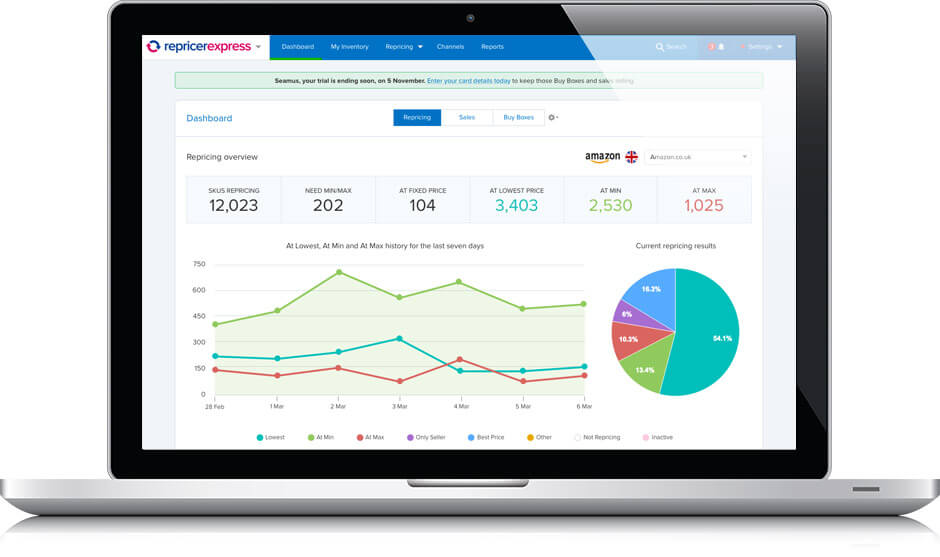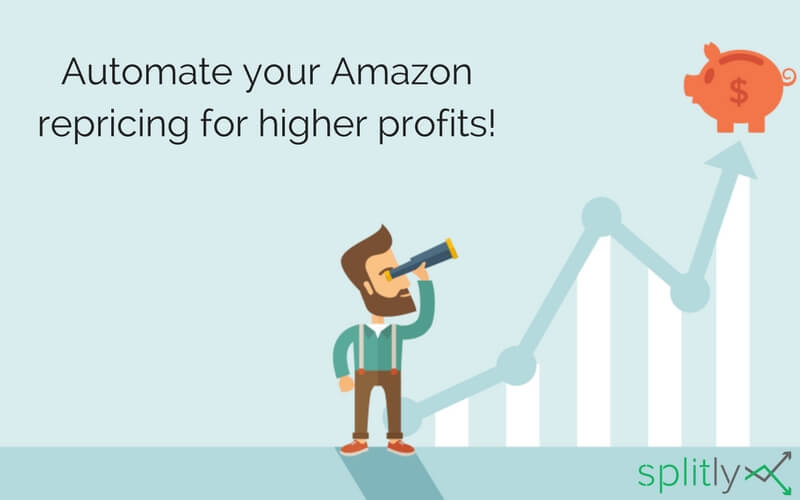Blog: Amazon Pricing: Long-Term Strategies For Increased Sales
Amazon Pricing: Long-Term Strategies For Increased Sales
Pricing strategies are so important for Amazon sellers, no matter which Amazon business model you are using. Often, a strong pricing strategy is the missing key to success, because the power of pricing is underestimated and not managed correctly. We asked Seamus from RepricerExpress to shed some light on long-term pricing strategies for maximum profits, taking into account the data they have from their repricing tool for Amazon sellers competing for the Buy Box.
_____
I remember some time ago looking at our Google Analytics account to see how traffic to our website was performing—it was relatively steady but over the last two days we had experienced a small dip. Of course, we delved a little deeper to check that everything was fine and indeed it was, but my boss got in touch to ask what was going on and what we should do about it. My reaction was to simply explain that it was a blip and that we should do nothing just yet—other than keep an eye on things.
That was the same month my friend emailed, laughing, and telling me that some stock he had bought the previous year had come good and made a nice little profit. He had emailed me specifically because I joked with him three months earlier about how that stock had seen a sudden dip in share price and how he might lose a lot of money. Was he going to sell quickly or hold his nerve and ride it out?

Amazon pricing decisions 🤔
When those two events happened at the same time, a funny thing dawned on me about the Amazon sellers who use our software. Many of the newer sellers would often watch their prices daily or during short periods of time to gauge how well they were doing. Some would email our support team asking why their product wasn’t selling, or why it had suddenly moved price. They would make decisions about their pricing from those isolated incidents and continue to react to events on Amazon in a similar fashion.
Here's the thing, Amazon pricing can decisions should be made over a longer period of time. Otherwise, you may be making harmful decisions that will impact you later on.
Experienced sellers have long-term pricing strategies
I noticed that our more experienced sellers would only log into RepricerExpress occasionally. When I asked a number of them why that was, it became apparent that they were basing their pricing strategies on much longer time periods and market conditions. A dip or spike in sales on one day wouldn’t have them changing prices frantically, just like I didn’t panic about our dip in traffic over two days, or like my friend didn’t panic when his share price dipped for a short period.

Whether you’re looking to build a solid business on Amazon, increase your traffic to your website, or increase your stock portfolio’s value, you’ve got to take a long-term approach. Your decisions must consider where you’re trying to take your Amazon business, what strategies you’re going to use to get more visibility, increase seller metrics and product reviews, and ultimately increase your sales and profits with pricing that’s sensible and delivers a good margin.
The strategy of a successful Amazon seller
Recently, an Amazon seller using our software was kind enough to share his pricing strategy for selling on Amazon with us. Kev Blackburn of LifeSuccessEngineer has over 750 products and 4,000 units in stock. With sales of more than £60,000 in the last 30 days, Kev is definitely doing something right! Here's an insight into Kev's strategy:
“We have the same common strategy for all types of stock. We work on a minimum 30% return on investment. We will hold our prices at 30% or higher and only adjust after three months of having that stock.”
Pretty simple, right?
Well yes, but many sellers just won’t trust in this approach. They often don’t realize that setting their Minimum and Maximum prices offers them huge flexibility for adjusting price over the long term.
For example: Kev sets his minimum floor price to 30% above his cost price plus fees. That pretty much guarantees him 30% margin on every sale he makes, and if market conditions are favorable, he could sell at much higher margins when RepricerExpress detects that his competition are out of stock or have inferior seller metrics to him.
How does this work for Private Label sellers?
Kev is selling products using the Wholesale method, so he knows that winning the Buy Box is crucial, but also that price is only one piece of the puzzle.
For private label sellers out there who are not competing for the Buy Box, the same story still applies. If you are selling private label and have no pricing strategy at all, then you are definitely leaving money on the table.

However, when you use software like Splitly, to split test, or even better, automate your pricing using machine learning with Profit Peak, you are implementing a long-term pricing strategy that has the flexibility to adapt to market conditions, competition and all of the variable moving parts on Amazon.
What if my products just aren’t selling?
Okay, remember that three-month period Kev mentioned? You could have a similar period set for reviewing how sales are progressing on your stock. When products haven’t sold within a certain period, move them to a more aggressive repricing rule. In RepricerExpress, that’s really simple to set up with our Automations functionality, allowing you to auto-detect when this happens.
Tip: Use Profit Peak to automate private label repricing, so you always have the best known price for maximum profits, whilst maintaining your Rank (BSR).
Here’s another example:
Twice per year Amazon charges you fees for the stock you hold in its fulfillment centers, on 15 February and 15 August. So for many sellers, they have decisions to make about whether to pay those fees, try to sell off their stock before the deadline or remove their stock from the fulfillment centre.
With a long-term pricing strategy, many sellers using our tools will have an Automation set which looks something like this:
- If FBA Long-Term Storage Fees are due,
- And stock is older than 4 months,
- And sales are less than X dollars,
- Then move them to a more aggressive pricing rule.
They will know that even by selling the stock off at a lower margin, it’s more profitable than holding on to it and paying further FBA storage fees.
Then there are different times of the year
Of course, most Amazon sellers will know which of their stock will sell at higher margins at certain times of the year. You may have a certain toy that you’re going to sell at Max in November and December because people are less motivated by price in such instances, and simply have to have the toy.
Again, with a great repricing tool, this should be relatively simple to set up and automate for those times of the year you want to adjust your repricing strategy for.
Some questions to ask yourself include:
- When you have those 100 new pairs of sneakers back in stock, consider a longer term view of the sell price:
- What’s the minimum price I want to sell at in the first X days?
- When do I need to have this stock sold by?
- What strategy will I employ if sales are much slower than expected?
- What strategy will I employ if sales are going too well and stock is running out?
- What times of the year might I be able to sell at a much higher margin?
- What’s my breakeven point on the stock as one lot?
These aren’t a finite list of questions you should consider, as every seller has different mixes of stock, different overheads and different goals, but they do move the focus to a long-term approach to selling on Amazon. As we’ve witnessed, the more experienced sellers who are still doing business and making money on the marketplace always adopt a long-term pricing strategy.
Conclusion
It’s difficult, but not impossible, to take a long-term approach to your pricing on Amazon manually. A manual approach would involve checking so many metrics constantly. However, if you are competing for the Buy Box, using an automated solution such as RepricerExpress will free up your time and do all the heavy lifting automatically. Uniquely, it can check lots of historical data, such as sales, stock and sales rank daily, and automatically move SKUs on to the right repricing rule at the right time.
It’s super easy to set up and works across Amazon and eBay. There is also a free 15-day trial for you to try out and see if it works for your business.
If you have any further repricing queries, get in touch via profit@repricerexpress.com and one of our great customer support team will get back to you asap.
About the author

